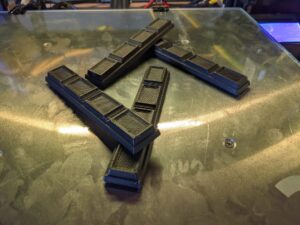3D printing is part of a wide category of manufacturing methods known collectively as “additive manufacturing”. These methods all share one theme in common: they produce a finished product by adding materials together and building it up. This differs from many traditional manufacturing methods known as “subtractive manufacturing” because it doesn’t form the finished product by taking away existing material.
Additive manufacturing refers to a specific set of manufacturing techniques in the industry. These techniques are often highly technical and require specialized machinery to achieve. Many of these methods use some form of heat or a chemical reaction to bind loose material together into the finished product. Processes like sheet lamination, powder fusion, and material extrusion are the backbone of additive manufacturing. FDM 3D printing falls into the material extrusion category.
What is Material Extrusion?
Material extrusion is exactly as it sounds: a special material is extruded from what is usually a heated nozzle onto a build surface. This extrusion happens in layers, so the piece is built up bit by bit until it reaches its final height. The basic concept works the same as a hot glue gun, but the managed flow rate and temperature is what allows the material to form a precise final piece.
The advantages of this additive manufacturing method are vast. A wide variety of materials can be formulated for extrusion including biodegradable plastics, fiber infused nylons, dissolvable materials, and even some metals. This makes the possibilities of material extrusion wider than most other additive manufacturing methods.
Material extrusion has other advantages as well:
- It doesn’t require as high of temperature as some other methods.
- The relatively straight-forward process makes it easy for beginners to learn.
- Lower production times than other more advanced techniques.
Are Additive Methods Better than Subtractive?
In many ways, yes. However both methods have their own pros and cons. Subtractive manufacturing is a more widely used method that has been around for a long time. Processes like milling, CNC, and laser cutting have been tested, improved, and utilized for part production for decades. The parts they produce are sturdy, precise, and can be made from a similarly wide range of materials as additive methods.
There are however a few perks to additive methods that are hard to ignore:
Weight & Density
Due to the nature of the process, subtractive manufacturing pieces will always have the same density as the material block they were cut from. This means that the parts are more likely to be heavy and it’s difficult to reduce weight without changing the material used.
In additive manufacturing, the density—or “infill”—of the piece can be changed to reduce overall weight of the part if needed. This ability to alter density also determines the strength of the piece, allowing for more flexibility in the structure of the finished part.
Waste Materials
With subtractive manufacturing, you start with a solid block or sheet of your chosen material, then cut away what is not needed until you have the remaining finished part. This process can seem pretty wasteful. In some situations the waste material can be collected and recycled in some way, but in others it just goes in the trash.
With additive methods, the only material the machine uses is what is being laid down or bonded to build up the final part. This means there is very little leftover material that can’t be recycled or reused. For material extrusion methods, there are even specialized machines that take old parts and scraps and turn them back in to usable material.
Customization of Design
A subtractive manufactured part is being formed from the outside, meaning the design of the part can be limited to certain structures. While the range of structures it can achieve are vast, there can always be something so complex that it’s just not physically possible to make it by cutting material away.
Additive manufacturing methods build the inside and outside of the part, so there is a wider range of possibilities with their designs. For example, “print in place” is a term used to describe multi-part 3D prints that have functional pieces built up all at once with the finished part like bearings and hinges. This opens the door for more creative designs that require less post-processing or assembly.
Machine Cost & Space
While more versions of subtractive machines are being condensed and made smaller, these machines are traditionally pretty large and take up a lot of space. This is great when you consider the size of parts they can produce, but it also means you usually need a dedicated space for the machines to live and run. These large machines don’t come cheap either. Expect to pay into the thousands of dollars to get a shop with these machines up and running.
Additive manufacturing machines like 3D printers tend to be smaller and require much less room to operate. Most 3D printers have a set size build surface, but newer models have been coming out with conveyor belt style build surfaces that allow you to print infinitely long pieces in a single run. All of these perks of smaller machines comes at a much lower price than people often think. An entry level 3D printer can be had these days for under $200, and raw material is fairly inexpensive as well.
The Bottom Line
Additive methods are really making an impact on the manufacturing industry as a whole, and for good reason! These methods have so many advantages for prototyping, fast production, and inexpensive entry costs that just can’t be overlooked. Not to mention the waste reduction opportunities! In a world where we constantly develop new things and ideas, why not aim to achieve it in a more practical and sustainable way?
Interested in having something 3D printed? We can help! Visit our industries page for some examples of the kinds of projects we take on as an additive manufacturer!



